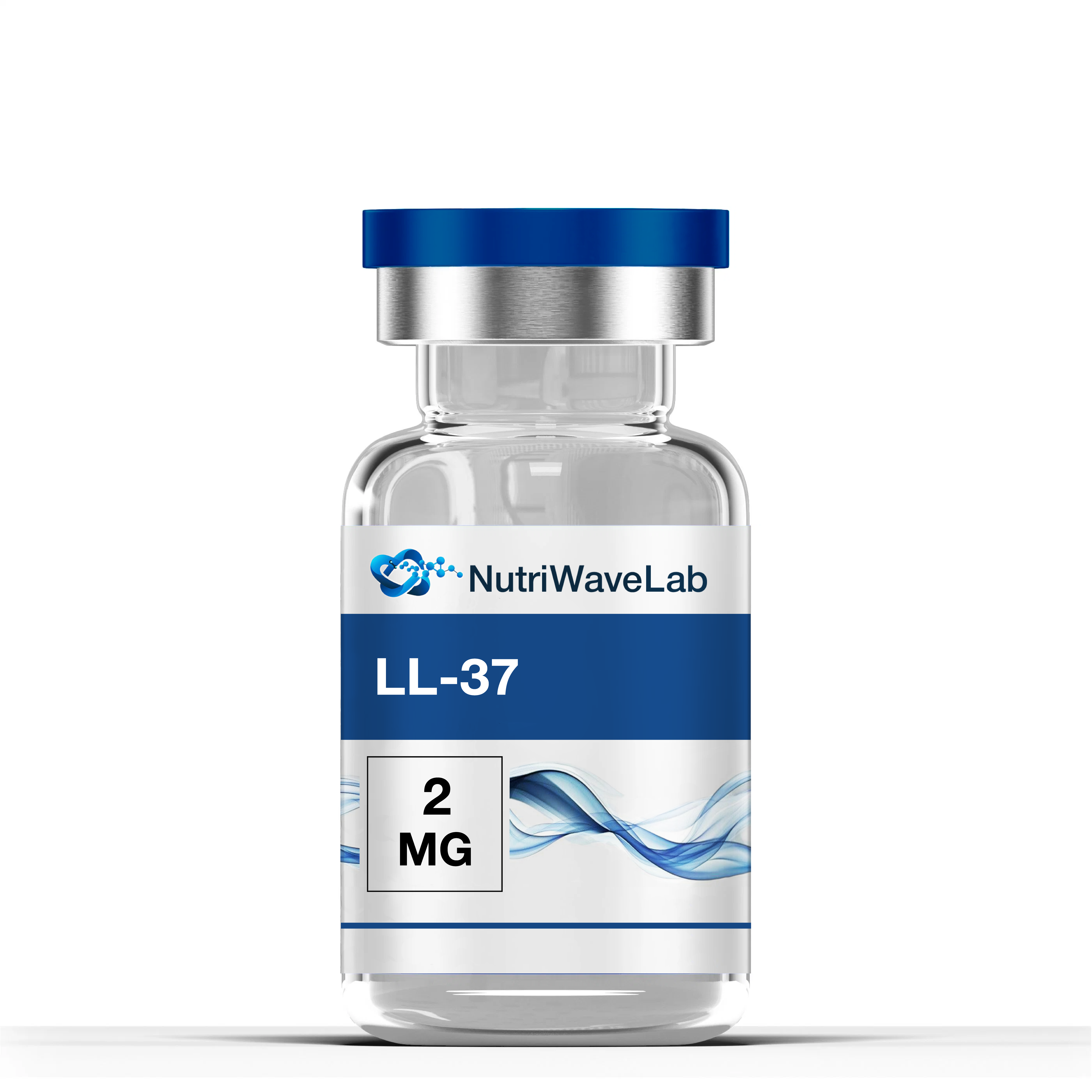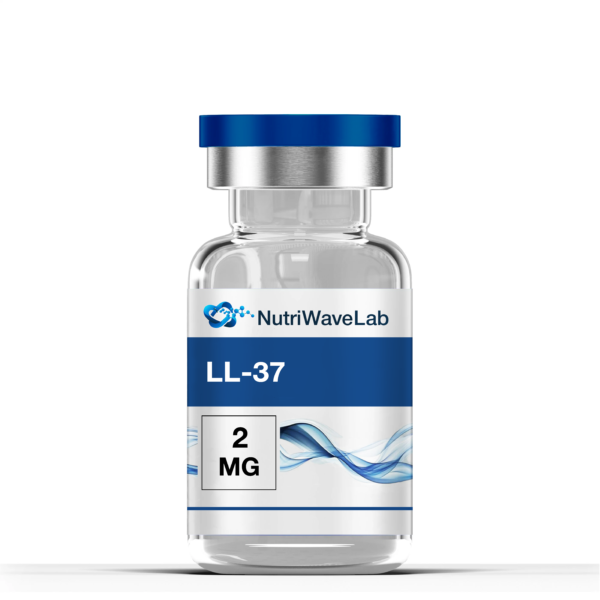LL-37 2mg
$0.00
- when buying 5 units of goods 5% discount
- when buying 10 units of goods 8% discount
17 in stock
LL-37 — Human Cathelicidin Peptide for Innate Immunity and Regeneration Research
Chemical and Biochemical Characteristics
-
Peptide Name: LL-37 (Human Cathelicidin)
-
Amino Acid Sequence: Leu-Leu-Gly-Asp-Phe-Phe-Arg-Lys-Ser-Lys-Glu-Lys-Ile-Gly-Lys-Glu-Phe-Lys-Arg-Ile-Val-Gln-Arg-Ile-Lys-Asp-Phe-Leu-Arg-Asn-Leu-Val-Pro-Arg-Thr-Glu-Ser
-
Molecular Formula: C₂₀₅H₃₄₀N₆₀O₅₃
-
Molecular Weight: 4493.34 g/mol
-
CAS Number: 154947-66-7
-
PubChem CID: 16198951
-
Synonyms: CAP-18 peptide, human cathelicidin, antimicrobial peptide LL-37
-
Peptide Class: Innate immune effector / host defense peptide
Overview
LL-37 is the only known human cathelicidin peptide, derived from its precursor hCAP-18 and stored in neutrophils, macrophages, and epithelial cells.
It represents a first-response molecule of the innate immune system, combining antimicrobial, anti-inflammatory, immunomodulatory, and angiogenic effects.
Unlike traditional antibiotics, LL-37 does not simply kill pathogens — it also orchestrates immune cell activation, modulates inflammatory signaling, and contributes to tissue repair and epithelial homeostasis.
Mechanism of Action
LL-37 exerts its biological activity through several overlapping mechanisms:
-
Membrane disruption: penetrates bacterial and viral membranes via amphipathic α-helical structure.
-
Immune activation: stimulates neutrophils, macrophages, and T cells, increasing interferon-γ release.
-
TLR modulation: regulates Toll-like receptor 2/4 responses, balancing cytokine expression.
-
Angiogenesis and tissue regeneration: enhances endothelial proliferation and wound healing.
-
Epigenetic signaling: can enter cell nuclei and modulate gene transcription, linking innate defense with genomic regulation【1】【2】.
Antimicrobial and Barrier Defense
LL-37 acts as a broad-spectrum antimicrobial peptide, effective against bacteria, fungi, and certain viruses.
It binds and neutralizes lipopolysaccharides (LPS) of gram-negative bacteria, disrupting membrane integrity and preventing endotoxin-induced inflammation【3】.
It also works synergistically with β-defensin-2 and lysozyme to amplify antibacterial defense in epithelial tissues【4】.
This dual role — direct microbicidal activity and modulation of host immunity — makes LL-37 an important target in research on antibiotic alternatives and mucosal immunity.
Immunomodulatory and Anti-Inflammatory Effects
LL-37 demonstrates complex, context-dependent immune behavior:
-
Enhances IFN-α production in early infection;
-
Reduces pro-inflammatory cytokines (IL-6, TNF-α) during chronic inflammation;
-
Supports T-regulatory cell formation and immune tolerance【5】【6】.
Studies indicate that LL-37 can act as a homeostatic modulator, dampening excessive inflammation seen in autoimmune and allergic conditions such as psoriasis, rheumatoid arthritis, and lupus【7】.
Tissue Repair and Angiogenesis
Beyond its immune activity, LL-37 promotes angiogenesis by upregulating prostaglandin E₂ (PGE₂) and activating endothelial EP3 receptors, stimulating new blood-vessel growth【8】.
It also encourages fibroblast migration, collagen deposition, and epithelial closure — key components of wound repair.
In respiratory and dermal models, LL-37 accelerates re-epithelialization and protects barrier tissues from further microbial invasion【9】.
Respiratory and Pulmonary Research
In pulmonary systems, LL-37 is produced by airway epithelial cells in response to bacterial endotoxin exposure.
It enhances epithelial cell proliferation and wound closure, suggesting a role in protecting against inhaled pathogens and environmental particulate injury.
Experimental studies propose its potential relevance in research on asthma, COPD, and post-infection fibrosis【10】.
Gastrointestinal and Mucosal Protection
Within the gut, LL-37 supports the intestinal epithelial barrier by:
-
Promoting cell migration and survival under inflammatory stress;
-
Limiting TNF-α-induced apoptosis;
-
Working synergistically with β-defensin-2 to maintain mucosal integrity【11】.
These observations make LL-37 a valuable molecule for studying inflammatory bowel disease (IBD) and gut–immune interactions.
Arthritis and Autoimmune Models
LL-37 is found in high concentrations in synovial fluid from rheumatoid arthritis models, suggesting a compensatory role in limiting joint inflammation.
Derived fragments of LL-37, such as IG-19, have shown protective effects against collagen-induced arthritis, reducing antibody titers and preserving cartilage integrity【12】【13】.
These findings position LL-37 as an important peptide for exploring autoimmune modulation and joint tissue repair.
Oncological Research and Vitamin D Connection
LL-37 has demonstrated anti-tumor properties in gastrointestinal and oral cancer models, where vitamin D signaling upregulates LL-37 expression in macrophages and epithelial cells【14】.
This mechanism may partly explain epidemiological links between vitamin D sufficiency and reduced risk of colorectal or gastric cancer.
Summary
LL-37 is a unique human host-defense peptide that bridges innate immunity, inflammation control, and tissue regeneration.
Its diverse mechanisms — antimicrobial, angiogenic, immunomodulatory, and epigenetic — make it a key focus in current biomedical research exploring:
-
Antimicrobial resistance models
-
Chronic inflammation and autoimmune regulation
-
Wound healing and vascular biology
-
Mucosal and epithelial protection
All formulations of LL-37 are intended solely for laboratory and educational research and are not approved for clinical or therapeutic use.
Selected References
-
Kahlenberg J.M., Kaplan M.J. The role of LL-37 in inflammation and autoimmune disease. J Immunol, 2013; 191(10): 4895–4901. PubMed
-
Alexandre-Ramos D.S. et al. LL-37 treatment modulates immune response and promotes regulatory T-cells. Biomed Pharmacother, 2018; 108: 1584–1590. PubMed
-
Ciornei C.D. et al. Antimicrobial and LPS-neutralizing activity of LL-37 analogs. Antimicrob Agents Chemother, 2005; 49(7): 2845–2850. PubMed
-
Chen X. et al. Synergistic antibacterial effect of LL-37 and β-defensins. J Dermatol Sci, 2005; 40(2): 123–132. PubMed
-
Golec M. Cathelicidin LL-37: LPS-neutralizing, pleiotropic peptide. Ann Agric Environ Med, 2007; 14(1): 1–4. PubMed
-
Brown K.L. et al. LL-37 selectively reduces pro-inflammatory macrophage responses. J Immunol, 2011; 186(9): 5497–5505. PubMed
-
Hoffmann M.H. et al. Cathelicidins LL-37 and rCRAMP in arthritis. Ann Rheum Dis, 2013; 72(7): 1239–1248. PubMed
-
Salvado M.D. et al. LL-37 induces angiogenesis via PGE₂–EP3 signaling in endothelial cells. Arterioscler Thromb Vasc Biol, 2013; 33(8): 1965–1972. PubMed
-
Shaykhiev R. et al. LL-37 stimulates airway epithelial cell proliferation and wound closure. Am J Physiol Lung Cell Mol Physiol, 2005; 289(5): L842–L848. PubMed
-
Otte J.M. et al. Effects of LL-37 on intestinal epithelial barrier integrity. Regul Pept, 2009; 156(1–3): 104–117. PubMed
-
Chow L.N.Y. et al. LL-37-derived peptide IG-19 protects against collagen-induced arthritis. Mol Immunol, 2014; 57(2): 86–92. PubMed
-
Chen X. et al. Roles and mechanisms of LL-37 in cancer and vitamin D signaling. Cell Physiol Biochem, 2018; 47(3): 1060–1073. PubMed
Product Use: THIS PRODUCT IS STRICTLY FOR SCIENTIFIC RESEARCH PURPOSES ONLY. It should only be used in laboratory settings. All product information on this website is provided solely for educational purposes. The law strictly prohibits introducing this product into the body of humans or animals. Only licensed professionals should handle this product. This product is not a drug, food, or cosmetic and should not be improperly classified or used as such.



Reviews
Clear filtersThere are no reviews yet.